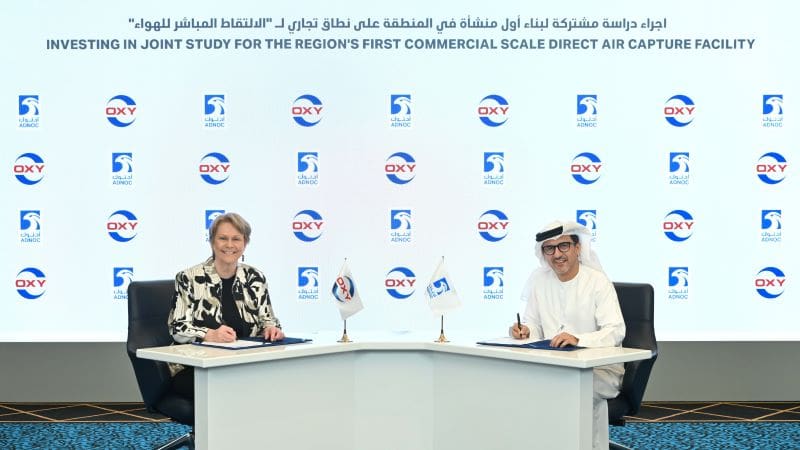Companies to jointly fund engineering study into first megaton direct air capture facility in the region
Abu Dhabi, UAE – ADNOC and Occidental announced, today, an agreement to undertake a joint preliminary engineering study for the construction of the first megaton-scale direct air capture (DAC) facility outside the United States (US).
The agreement is the first project to reach the technical feasibility stage since the two companies signed a strategic collaboration agreement, in 2023, to explore carbon capture, utilization and storage (CCUS) projects in the UAE and the US.
The study will assess the proposed one million tonnes per annum (mtpa) DAC facility to be connected to ADNOC’s carbon dioxide (CO2) infrastructure for injection and permanent storage into saline reservoirs not used for oil and gas production. ADNOC is in the testing phase of the world’s first full sequestered CO2 injection well in a carbonate saline aquifer in Abu Dhabi.
Musabbeh Al Kaabi, Executive Director for Low Carbon Solutions and International Growth at ADNOC, said: “Today’s announcement represents continued positive momentum in our partnership with Occidental to significantly scale up promising carbon management technologies. This joint investment in the proposed first megaton direct air capture facility in the region exemplifies ADNOC’s commitment to leverage partnerships and promising technology to accelerate our decarbonization journey on the way to net zero by 2045.”
In August, ADNOC and Occidental signed a strategic collaboration agreement (SCA) to evaluate potential investment opportunities in CO2 capture and storage hubs in the UAE and US and to incorporate climate technologies in energy projects such as emissions-free power and sustainable fuels.
Vicki Hollub, President and CEO of Occidental, said: “The speed at which the Oxy and ADNOC teams have developed the feasibility and Pre-FEED plan for a DAC plant in Abu Dhabi underscores the urgency needed to deliver global-scale climate solutions and eliminate greenhouse gas emissions. We will continue to leverage our carbon management expertise to deliver value and accelerate our ability to achieve our net-zero targets and help others meet theirs.”
Recently, as part of its carbon management strategy, ADNOC announced a final investment decision to proceed with one of the largest carbon capture projects in the Middle East and North Africa (MENA) region at Habshan, with the capacity to capture up to 1.5 million tonnes per annum (mtpa) for permanent storage in Abu Dhabi’s onshore reservoirs. This strategy aligns with the Intergovernmental Panel on Climate Change’s (IPCC) view that carbon capture and storage is a critical enabler for the world to achieve net zero by mid-century.
About ADNOC
ADNOC is a leading diversified energy and petrochemicals group wholly owned by the Emirate of Abu Dhabi. ADNOC’s objective is to maximize the value of the Emirate’s vast hydrocarbon reserves through responsible and sustainable exploration and production to support the United Arab Emirates’ economic growth and diversification. To find out more, visit: www.adnoc.ae
For media inquiries, please contact: media@adnoc.ae
About Occidental
Occidental is an international energy company with assets primarily in the United States, the Middle East and North Africa. We are one of the largest oil producers in the U.S., including a leading producer in the Permian and DJ basins, and offshore Gulf of Mexico. Our midstream and marketing segment provides flow assurance and maximizes the value of our oil and gas. Our chemical subsidiary OxyChem manufactures the building blocks for life-enhancing products. Our Oxy Low Carbon Ventures subsidiary is advancing leading-edge technologies and business solutions that economically grow our business while reducing emissions. We are committed to using our global leadership in carbon management to advance a lower-carbon world. Visit oxy.com for more information.






